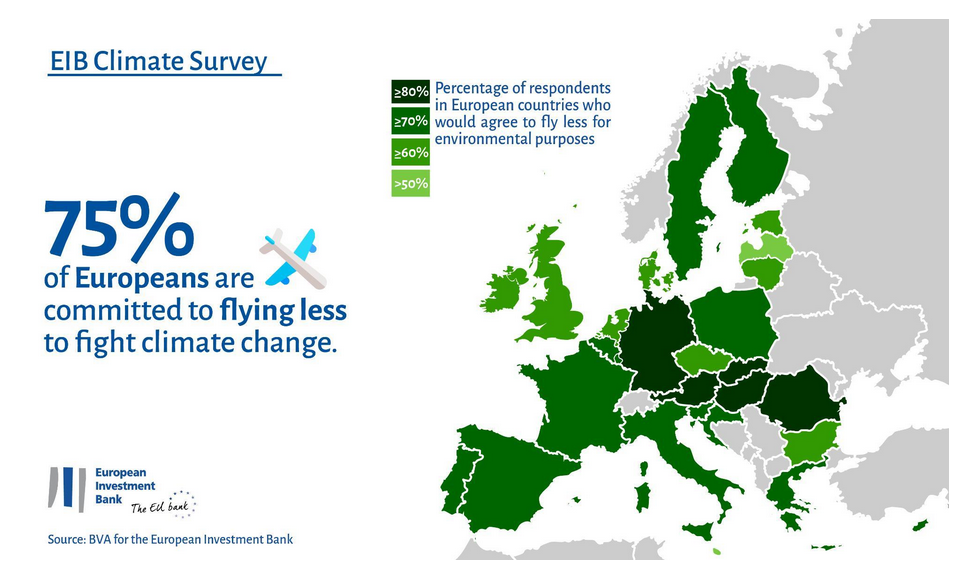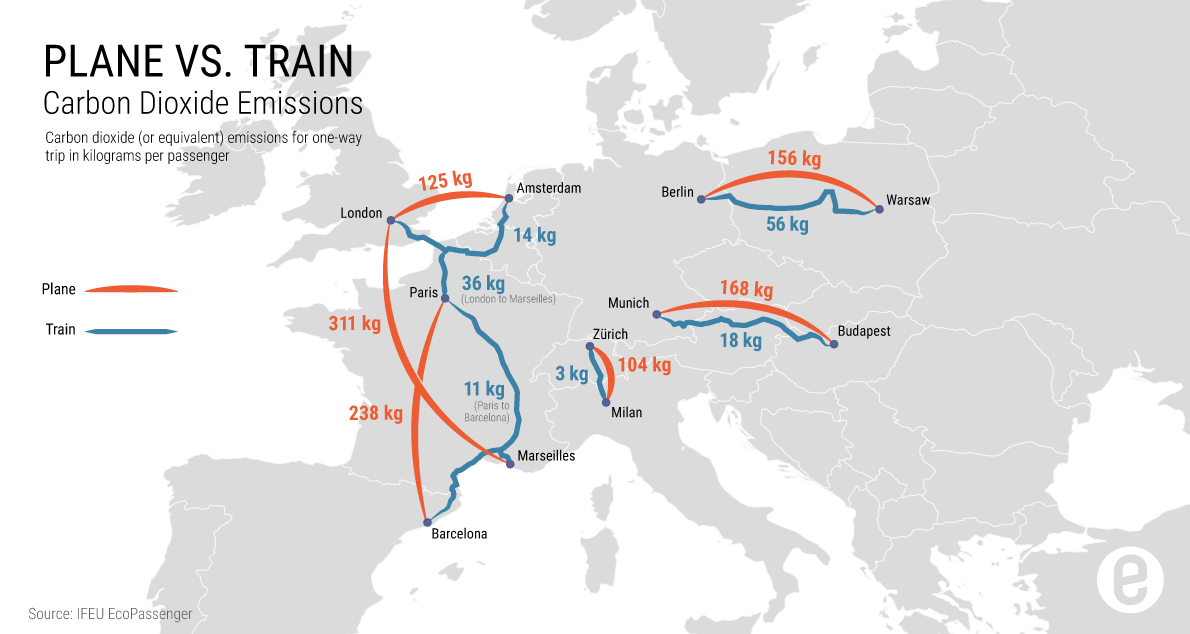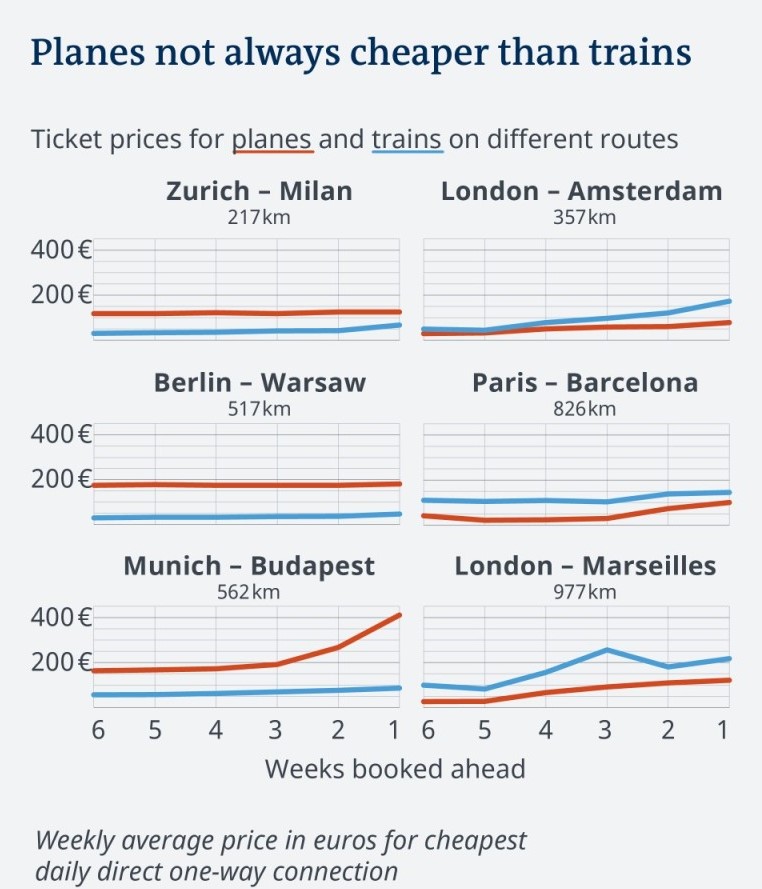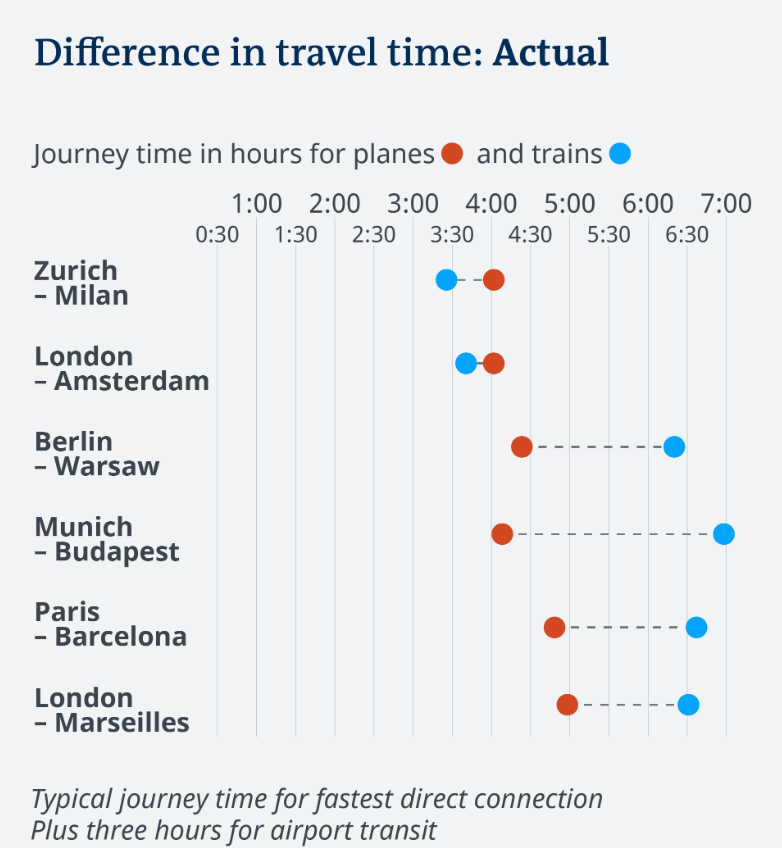Flight-shaming and rethinking the “transport” element in tourism
June 7, 2006
Posted By: Polihron Karapachov
Subsequently, Greta Thunberg became the face of the no-fly movement, or more popular with the Swedish term “flygskam”, where people aim to drastically reduce the number of flights they take or give up air travel altogether. The emergence of Greta, as a consequence, facilitated the 10% decline in flights between Stockholm and Malmo and the 20% increase in train ticket sales. Furthermore, SAS saw a decline of 2% in passengers while Sweden’s domestic airport operator serviced 9% fewer travellers in 2019 compared to last year. As a result, both companies blamed the flight shame movement.

Source: European Investment Bank
Currently flying contributes only between 2-3% to the human-induced CO2 emissions, however, it is predicted to grow up to 16% by 2050. Furthermore, the UN Aviation body predicts that airplane CO2 emissions will triple by 2050 and despite the efforts from the airline industry, to become more fuel-efficient demand outstrips any of that effort. The growing middle class in Asia, together with the rapid growth of low-cost airlines has led the world’s fastest-growing airports to be in emerging economies; 12 of the top 30 in either China or India. Despite the development of biofuels and airplanes becoming more efficient, the constant growth of tourism and people who traveller will most certainly neutralise these actions.
So which are the alternatives and can the train be really an effective solution?

Currently flying contributes only between 2-3% to the human-induced CO2 emissions, however, it is predicted to grow up to 16% by 2050. Furthermore, the UN Aviation body predicts that airplane CO2 emissions will triple by 2050 and despite the efforts from the airline industry, to become more fuel-efficient demand outstrips any of that effort. The growing middle class in Asia, together with the rapid growth of low-cost airlines has led the world’s fastest-growing airports to be in emerging economies; 12 of the top 30 in either China or India. Despite the development of biofuels and airplanes becoming more efficient, the constant growth of tourism and people who traveller will most certainly neutralise these actions.
So which are the alternatives and can the train be really an effective solution?

Source: IFEU EcoPassenger
Looking at data trains are a significantly more sustainable option than airplanes. The majority of trains in Europe are mainly powered by electricity, although diesel trains are quite common in some countries. In Sweden, Norway or Finland where the majority of trains are electric, the average emission factor is 10g CO2 per passenger-km, compared to 163g in Economy scheduled flight. However major setbacks for people when choosing between a train and a plane are the prices and the travelling time.

Source: Deutsche Welle
As can be seen from the graph above, trains are not always cheaper than flights while there is also the notion that in general trains are not really a convenient solution, because of the travelling time. However, it is important to note that in the majority of cities, train services run from city centre to city centre, meaning that travellers do not have to experience the inconveniences of waiting at the gate, passing through the security and travelling to/from the airport.

Source: Deutsche Welle
Looking at data trains are a significantly more sustainable option than airplanes. The majority of trains in Europe are mainly powered by electricity, although diesel trains are quite common in some countries. In Sweden, Norway or Finland where the majority of trains are electric, the average emission factor is 10g CO2 per passenger-km, compared to 163g in Economy scheduled flight. However major setbacks for people when choosing between a train and a plane are the prices and the travelling time.

As can be seen from the graph above, trains are not always cheaper than flights while there is also the notion that in general trains are not really a convenient solution, because of the travelling time. However, it is important to note that in the majority of cities, train services run from city centre to city centre, meaning that travellers do not have to experience the inconveniences of waiting at the gate, passing through the security and travelling to/from the airport.

Source: Deutsche Welle
Data also shows that high-speed trains, for example, are easily embraced by people and especially business travellers. The high-speed rail service that was introduced between Barcelona and Madrid in 2008 helped for the decrease of people flying between the two cities almost by 50%, while at some routes high-speed trains could reduce air traffic by 80%. As train stations are easier to access, tickers are more flexible, travelling more comfortable and quite punctual, then why this type of transport still can’t compete with airplanes and what are some of the options in front of policymakers to deal with the challenge of reducing the carbon emissions by airplanes?
Issues with trains
Looking at Europe as the continent which has the most developed railway network, the connection between cities in different countries is still quite inconvenient and costly. For example, taking a train between London and Barcelona will take 16 hours and cost more than 150 EUR, while a 2-hour flight could cost less than 40 EUR. On the other hand, travelling with a family could be very challenging and time-consuming, especially having in mind the limited vacation time that people have.
Frequent flyer memberships need to be redesigned
Looking at Europe as the continent which has the most developed railway network, the connection between cities in different countries is still quite inconvenient and costly. For example, taking a train between London and Barcelona will take 16 hours and cost more than 150 EUR, while a 2-hour flight could cost less than 40 EUR. On the other hand, travelling with a family could be very challenging and time-consuming, especially having in mind the limited vacation time that people have.
Frequent flyer memberships need to be redesigned
The current structure of frequent flyer memberships is one that rewards frequent flying and in the context of climate change, airlines need to adopt a model that disincentives it. In fact, in a recent report commissioned by the UK’s Climate Change Committee, it is stated that regulations concerning the banning of frequent flyer reward schemes, that stimulate demand, should be introduced. Furthermore, the report has also proposed the introduction of “air miles levy”, which would be increasing according to the miles flown to target frequent flyers.
Carbon Tax
Various experts have raised the idea of introducing a global carbon tax on air travel, which would push consumers to choose more environmentally friendly options. Last year, nine European countries came with a proposal to the European Commission calling for some form of an aviation tax. According to their statement, it is unacceptable that air travel is not taxed at all, unlike travel by car, bus or train. Furthermore, if the EU does not reach an agreement by the end of 2020 regarding this issue, the Netherlands has stated that it will adopt its own national flight tax.
Reduction of flights and stimulating train travel
Except for taking action on cheap fares, an additional solution is the reduction of flights between nearby destinations and opening more train options. For example, KLM will replace one of its daily flights Amsterdam-Brussels with train seat capacity on a Thalys. On routes like Amsterdam-Paris, Paris-London, Brussels-London, Barcelona-Madrid, which already have good rail connections, there are some strong arguments for the reduction of daily flights and stimulating passengers to choose trains instead. However, the introduction of such policies would need a change in taxation, including even subsidizing train tickets and restructuring the rail sector in Europe.
European railway network
Much of Europe high-speed rails weren’t developed through joint cooperation between countries and as a result this has created a system which is not coordinated and lacks the fluidity of the flight sector. As a result multi-leg international journeys are quite difficult to book and if possible they are very expensive. A recent report by the European Court of Auditors highlighted that there are currently 11 000 national rules which act as a barrier for transnational travel. There isn’t a harmonized approach for cross-border rail transport and for example a train passing through Italy and Austria would have to do an obligatory layover at the border and make operational changes required by Italian and Austrian national legislation. In comparison air traffic is harmonized and aircraft fuel does not even get taxed.
The growth of air travel has reshaped humanity and it has made it possible to visit easily new continents, explore remote destinations, do business and even keep close contact with family and friends. Although at the moment flying produces only 2% of the carbon emissions, due to the predicted growth of tourism its effect could significantly increase. Strict bans or restrictions would not be well received by society, however encouraging research and development of new fuels, investments in high-speed railway infrastructure and taxation on dirty fuels may drive customer demand to other types of transportation. People are becoming more conscious about their travel habits and their greenhouse emissions, and movements like “flygskam” show that there is a strong cultural shift. And quite often political changes follow cultural ones.
Similarly to the previous intakes of TOPOSOPHY on food waste and single-use plastic, in the midst of a climate crisis, transport is another aspect of tourism that needs detailed evaluation and it requires a cross-sectoral shift. Addressing sustainability goals, destinations need to develop new strategies and products which foster sustainable travel and easy access through a wide variety of transportation methods. That was among key takeaways from our work over the Destination Management Plans of Rhodes and Santorini, where specific actions were recommended both for in-island transport and connectivity options with other destinations. Companies also need to redesign their business travel programmes and take advantage of contemporary technology. At the same time, policymakers have to develop policies that would stimulate demand for more sustainable travel.
Drop us a line at info@toposophy.com if you wish to explore more opportunities for eco-friendly and cost-efficient solutions in your transport plans.
Carbon Tax
Various experts have raised the idea of introducing a global carbon tax on air travel, which would push consumers to choose more environmentally friendly options. Last year, nine European countries came with a proposal to the European Commission calling for some form of an aviation tax. According to their statement, it is unacceptable that air travel is not taxed at all, unlike travel by car, bus or train. Furthermore, if the EU does not reach an agreement by the end of 2020 regarding this issue, the Netherlands has stated that it will adopt its own national flight tax.
Reduction of flights and stimulating train travel
Except for taking action on cheap fares, an additional solution is the reduction of flights between nearby destinations and opening more train options. For example, KLM will replace one of its daily flights Amsterdam-Brussels with train seat capacity on a Thalys. On routes like Amsterdam-Paris, Paris-London, Brussels-London, Barcelona-Madrid, which already have good rail connections, there are some strong arguments for the reduction of daily flights and stimulating passengers to choose trains instead. However, the introduction of such policies would need a change in taxation, including even subsidizing train tickets and restructuring the rail sector in Europe.
European railway network
Much of Europe high-speed rails weren’t developed through joint cooperation between countries and as a result this has created a system which is not coordinated and lacks the fluidity of the flight sector. As a result multi-leg international journeys are quite difficult to book and if possible they are very expensive. A recent report by the European Court of Auditors highlighted that there are currently 11 000 national rules which act as a barrier for transnational travel. There isn’t a harmonized approach for cross-border rail transport and for example a train passing through Italy and Austria would have to do an obligatory layover at the border and make operational changes required by Italian and Austrian national legislation. In comparison air traffic is harmonized and aircraft fuel does not even get taxed.
The growth of air travel has reshaped humanity and it has made it possible to visit easily new continents, explore remote destinations, do business and even keep close contact with family and friends. Although at the moment flying produces only 2% of the carbon emissions, due to the predicted growth of tourism its effect could significantly increase. Strict bans or restrictions would not be well received by society, however encouraging research and development of new fuels, investments in high-speed railway infrastructure and taxation on dirty fuels may drive customer demand to other types of transportation. People are becoming more conscious about their travel habits and their greenhouse emissions, and movements like “flygskam” show that there is a strong cultural shift. And quite often political changes follow cultural ones.
Similarly to the previous intakes of TOPOSOPHY on food waste and single-use plastic, in the midst of a climate crisis, transport is another aspect of tourism that needs detailed evaluation and it requires a cross-sectoral shift. Addressing sustainability goals, destinations need to develop new strategies and products which foster sustainable travel and easy access through a wide variety of transportation methods. That was among key takeaways from our work over the Destination Management Plans of Rhodes and Santorini, where specific actions were recommended both for in-island transport and connectivity options with other destinations. Companies also need to redesign their business travel programmes and take advantage of contemporary technology. At the same time, policymakers have to develop policies that would stimulate demand for more sustainable travel.
Drop us a line at info@toposophy.com if you wish to explore more opportunities for eco-friendly and cost-efficient solutions in your transport plans.

COMMENTS